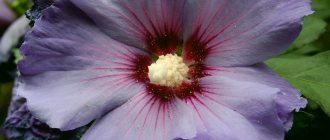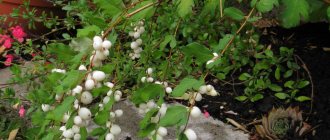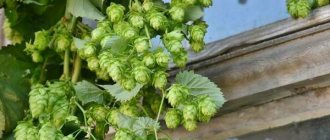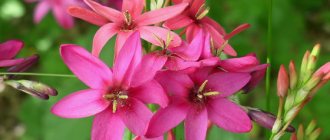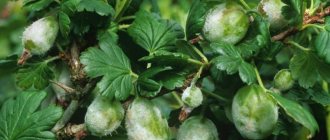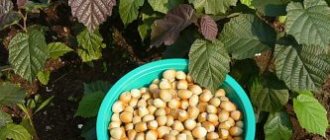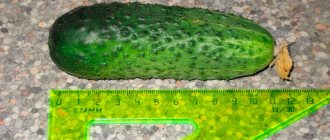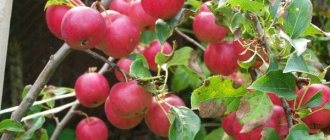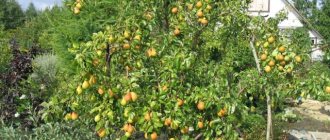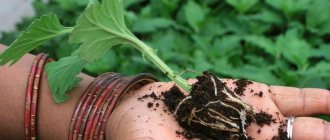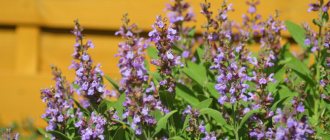Encyclopedia of Plants
Most often we are used to seeing ferns in forests, growing in the shade of trees. But these simple plants have become a wonderful addition to a shady garden. Fern in the garden, tolerates sub-zero temperatures well, thrives in summer cottages or garden plots. Many of them are native plants and come in a wide variety of colors, shapes and sizes. This culture has recently become increasingly popular in garden landscape design. Let's try to understand the types of fern and its use for decoration purposes.
- 1 Description of fern
- 2 How to plant and care for ferns in the garden
- 3 Why does the fern in the garden turn yellow?
- 4 Fern propagation by spores and dividing the bush
- 5 Transplanting a fern 5.1 How to divide a fern when replanting
Description of fern
Ferns (Polypodiophyta) are vascular plants (meaning they have specialized tissues that conduct water and nutrients) and belong to the group Moniliformopses. This is probably the oldest plant on our planet (fern fossils have been found dating back more than 360 million years). There are approximately 12,000 species of ferns, varying in size and habitat type. These plants can be found all over the world. They live in shady places that provide sufficient moisture, such as forests, meadows, swamps and coastal areas of rivers and lakes.
The fern can survive in different climates and at different altitudes. They can feel great in a shady forest, rocky area or in the mountains between rocks. These plants are among the oldest living organisms on the planet. People use ferns in the garden mainly for decorative purposes. Several fern species are known as invasive species due to their increased reproduction rates and ability to quickly occupy new habitats.
The culture can be either herbaceous or woody. Plants do not have leaves in the classical sense. What visually resemble leaves is actually a huge system of branches that are located on the same plane. The botanical name is frond or flat branch.
You can also read the article “Indoor types of ferns: features of plant care”
Description of the crop, its known varieties and varieties
About 200 of these wonderful plants are known in the world, most of which are inhabitants of tropical forests. If you look in general at the various types of ferns, you can note the following biological features of the plant:
- Perennial herbaceous shrub.
- Externally, a fern can look like either short grass or a rather impressive tree.
- Under the ground there is a medium-sized creeping rhizome.
- Above the surface is a dense stem consisting of wire tissue.
- The crop does not have real leaves. The so-called fronds - primitive leaf plates - extend from the stem. Their formation occurs in the roots in the spring.
fern bush
- Reproduction occurs with the help of spores located in brown bulges, clearly visible in the photo of the underside of the leaves.
- Ferns make ideal plants for shady corners.
- Planting is possible both in open ground and in flowerpots.
Attention! Growing heat-loving representatives in the middle zone is possible only in a room.
The following species and varieties thrive in open ground in temperate climates:
- The common ostrich is the most common type of fern found in gardens. This species requires minimal care.
- Common bracken - young shoots of this species are eaten.
- Male shieldweed - often found in the forests of the middle zone.
- Nomad fern - most of its varieties have an unusual reddish color. For example, Burgundy Lace leaves are wine-colored. These varieties look especially striking in the fall.
Nomadic fern
- Multi-row - in gardens you can find two varieties: Brown's fern and bristlecone fern.
- Leaflet - Japanese and scolopendra varieties. They are distinguished by low growth and very delicate leaves.
- Adiantum are common varieties of lady's hair and stop-shaped. They do not tolerate cold winters. It is recommended to grow them in open ground only in the southern regions.
How to plant and care for ferns in the garden
Ferns are generally low-maintenance and hardy, but they do require a little care to grow lush and large. This plant is easy to grow and is suitable for planting almost anywhere in your garden. Its endurance depends on the species.
In order for a plant to please with its attractive appearance, it must be planted correctly. Follow this procedure:
- Prepare the holes on the site, and then create a special soil composition. Usually, leaf soil, a little sand and peat are used for this.
- A little compost is placed at the bottom of the hole.
- The prepared and moistened fern sprout should be placed in the hole, spreading the rhizome evenly. Do not remove any remaining soil from the specimen to avoid damaging it.
- Then sprinkle the seedling with soil, and be sure to mulch the top layer.
If you want to acquire this lush plant on your site, it is also important to pay attention to the following recommendations:
- Find the perfect spot for your fern in your garden.
Before you plant ferns in your garden, keep in mind that the crops like plenty of shade and moisture, and do well under the canopy of a few other larger plants or trees. Plant (or transplant) the fern in a shady area out of direct sunlight. If you plant crops in areas with direct sunlight, their leaves will burn. - Keep the soil moist.
If your area does not receive regular rainfall, you will need to water your ferns daily to maintain moisture in the soil. Add a dense layer of pine needles or leaf mulch about 5 - 7 cm thick. This will help retain moisture and keep evaporation rates low - the air near the ferns will be more humid. - Fertilize your ferns once a month.
Six months after initial planting, you can begin feeding your ferns for additional growth. Select an organic fertilizer that is sprayed and apply it to the ferns (following the package directions). Additionally, you can add a layer of compost and mulch to the soil to create a better environment for ferns to grow. Keep in mind that ferns need less fertilizer than other plants. - Plant pruning.
Ferns don't have many natural pests outdoors, other than snails and one or two rare diseases. However, if you notice damage or disease on your fern leaves, use garden shears to cut them off. This will keep the rest of the plant intact and prevent it from spreading to other plants. - Replant if necessary.
Ferns can become quite large over time and require repotting. To divide a large fern into several smaller ones, carefully dig up the plant and its roots. Carefully break the plant into pieces. Then replant each plant and water well.
To ensure that the fern in the garden always pleases you, we offer a few more secrets of caring for it:
- planting garden fern is most optimal in early spring or early September, since at any other time the crop simply will not take root;
- leave enough space for the bush, since the fern requires a lot of space to create a beautiful shape;
- Plant large varieties at a distance of 50-60 cm, medium ones – 35-40 cm, small ones – 20-25 cm;
- creeping species (for example, horsetails) require the use of barriers, this will create an amazing landscape ensemble.
Using ferns in the garden, you can create an amazing design that will highlight your impeccable taste.
Why does the fern in the garden turn yellow?
Sometimes growing ferns in the garden can be challenging. For example, gardeners often complain that the leaves of a crop begin to turn yellow. This phenomenon can be a consequence of:
- violations of the irrigation system;
- exposure to ultraviolet rays;
- lack of nutrients in the soil.
With an excess or lack of moisture, the leaves of the plant begin to change their color. To get rid of this problem, you need to adjust the irrigation system.
A sufficient amount of nutrients in the soil is of great importance. It is recommended to fertilize ferns in the garden with urea by spraying. To do this, take 1 g of the substance per 1 liter of water. Liquid mineral fertilizers are also suitable for crops. The optimal solution is to use ammonium nitrate (1.5 g), potassium salt (1 g) and superphosphate (1.5 g). All components are mixed, and 50-100 ml of the prepared composition is added under one bush.
Fern propagation by spores and dividing the bush
Ferns can be propagated in the garden in two ways - by spores and by dividing the root. To obtain young and beautiful club mosses or other varieties of crops, spore propagation should be used. The spores are located in sporangia, which are located in sori. When the sporangia are ready to release seed, they turn brown. They are cut from the plant and stored in a paper wrapper until completely dry.
You can learn more about the propagation of ferns from this video.
Prepared seeds are planted in soil prepared from:
- sand and brown peat (1:3);
- sand, high peat, leaf soil (1:1:2);
- ready-made soil mixture suitable for violets.
After sowing, place the container in a room where the temperature does not drop below +15°C. Young seedlings can form spores in 2-3 months, but sometimes this process drags on for 3 years. Spores that have sprouted are planted in the ground.
The second option for propagating garden fern is by dividing the root. The method is used much more often, since with its help it is possible to achieve better results. The procedure for dividing the fern itself is described below. After dividing the rhizome into several parts, each of them is planted in a separate container. After such a procedure, caring for the fern is very important - its timely watering.
Reproduction methods
Fern propagation is possible in 3 main ways:
- The easiest way is to divide the bush . It is based on dividing the bulbs and then planting them on a marked area. It is preferable to carry out such work in the spring. When storing a divided bush over the winter, not all specimens can survive it.
- Reproduction by rhizomatous tendrils . In this way, species of ferns that grow tendrils are planted. Thus, cordifolia nephrolepis has the appearance of above-ground shoots that spread along the ground. They are buried 8-12 cm into the ground, watered intensively and soon a new plant appears.
- Reproduction by brood buds . This is the most time-consuming and least productive method. For planting, separate the buds (these are small tubercles on the bottom of the leaf), place them on peat soil or moss, moistening them daily. Then each spore is covered with a jar and put in a warm place. Within a short period of time, the “babies” take root, and after a month they are planted in the soil as a full-fledged plant.
Fern propagation by brood buds
The video explains how to plant ferns correctly:
plant seedlings
It is better to plant seeds in open soil that have previously been grown to the desired size. A peat-earth mixture is most suitable for fern growth, because from it it will receive the necessary components in order to grow and develop the root system.
Different varieties are planted in each box and additional nutrients are added. Different types of plants need appropriate fertilizers - compost, nitrogen, chalk and other substances.
Each package with a certain variety has an inscription indicating suitable minerals and can be purchased at a garden store. If the gardener collected spores himself, you should not apply any fertilizer.
If the plant species is unknown, it may react unpredictably.
The soil is heated; for this purpose, the vessel with it is placed on water vapor and heated repeatedly. It is recommended not to deepen the seeds, but only sprinkle them with soil on top.
Fern transplantation
Lovers of forest plants often wonder whether it is possible to plant a forest fern in the garden, and how to replant a fern in general?
Spring is the best time to replant ferns in the garden or from the forest to the garden. This procedure is simple. Simply dig a hole in the ground deep enough for the plant's root to enter completely and twice as wide. Take the plant out of the old place (if you are replanting a garden fern) or take out a fern brought from the forest and place it in a hole, then fill the sides with a soil mixture of soil, sand and peat (fine bark mixed with moss may be suitable for indoor plants).
After transplanting, water the fern; you can add a layer of mulch to retain moisture.
How to divide a fern when transplanting
First, we want to warn you that not all types of fern can be divided into two separate full-fledged seedlings. Only plants that have formed two or more growing points can be divided. Remember, after division, each seedling must have its own root.
You should start by watering the plant the day before you plan to divide it. Next, carefully dig up the plant (or remove it from the pot) and then cut or split (stretch) it into two clumps. After that, you can seat them in different places. This propagation method can be applied to both indoor and garden ferns.
Proper care of garden ferns
Ferns need to be cared for like any other flower. It is especially strictly necessary to observe a number of conditions necessary for him in the first year after transplantation:
- The soil in which this spore plant grows must be moist. It has already been said that it needs moisture. The fact is that during the first year after transplantation, this requirement is especially important.
- Feeding. Ferns, like people, sometimes need minerals and vitamins. Therefore, in spring and summer it is recommended to feed them with fertilizers. You can buy them at any floriculture store.
Note! It is strictly forbidden to use fertilizers if the fern has just been transplanted (at least three months must pass after this), as well as if the soil is dry, to avoid burning the roots. If the plant is weak, it is recommended to fertilize it not by the root method, but by irrigating the leaves. The fertilizing solution must be weak.
- Loosening. Ferns have developed root “breathing”. This means that they are saturated with oxygen not only through the fronds, but also through the roots, and more actively than many other flowers. Therefore, it is impossible for the earth around them to cake; it is recommended to loosen it from time to time.
Ferns are an ideal plant for beginning gardeners. Growing it takes minimal effort. Still, you should not let the growth of flora take its course; you must pay due attention to any flower in your garden.
We use forest fern in garden landscape design
Before using the culture to decorate your garden, be sure to read the description of the fern. The planting location, as well as the crops that will be located next to it, depend on its height, width and variety of leaves. Since most ferns prefer partial shade or shade, it is necessary to create secluded corners for such plants. The crop is best planted on the north side of the site with evenly moist soil.
An example of the use of fern in garden landscape design
When using seedlings to create decorative compositions, consider their growth rate. Because they have long rhizomes, they can crowd out neighboring crops. For garden plots, it is better to buy ferns with short roots so that their size and location remain more or less stable. A good idea is to plant ferns next to shrubs whose roots are exposed. Thanks to the wide leaves of the plants, such an unpresentable defect will be eliminated. Also, fern in the garden looks great in combination with bergenia and other shade-loving crops.
It is appropriate to use culture in the design of alpine slides and ponds. The maidenhair variety is ideally suited for this. For shady areas, the best option is a three-part multi-row.
Popular varieties
To achieve success when cultivating ferns in the garden, you need to choose the right type of plant.
Female Kochedyzhnik
This crop is characterized by dissected leaves that form bunches. Under natural conditions, it grows in swamps, forming hummocks. The size is determined by the crop variety and can reach 30-70 centimeters. The roots of the bush are short and thick.
Common bracken
This plant reaches 70 centimeters in height. It grows well in dry soil, which contains a small amount of useful substances. The culture is characterized by long horizontal leaves resembling eagle wings. The plant contains toxic substances, which is why it poses a danger to pets. Moreover, this type of fern is absolutely harmless for people.
Male shieldweed
Under natural conditions, the culture develops in the shade and reaches 0.3-1.5 meters. Pores resembling a shield accumulate on the underside of the leaves.
Common ostrich
This crop is distinguished by feathery leaves that resemble the openwork pattern of ostrich feathers. They can reach 1.5 meters in size. With the arrival of spring, the leaves become like a rolled cocoon. Then they bloom and resemble a luxurious cone. The vertical root system requires systematic loosening and mulching.
Asplenium
The culture is popularly called Kostenets. Most aspleniums need warmth. However, there are also frost-resistant crops that can withstand temperatures down to -18 degrees.
See also
When is it better to plant crocuses in open ground, care rules and growing features
Nest-like asplenium
This plant is able to grow even without soil, since under natural conditions it takes root on leaves and trunks. The size of the culture reaches 1 meter. Its dwarf species are found in flower shops.
Bulbous asplenium
This is a deciduous fern native to New Zealand. It can be grown in the garden. In this case, it is recommended to cover the root system with dry leaves. You can also dig up the bush and keep it in the cellar until spring arrives. The length of the plant reaches 60 centimeters.
Medicinal properties of fern
The aerial part of the plant contains a large number of alkaloids. The root system is also very useful for humans; it helps to cope with diseases of the stomach and intestines. Powder based on dried fern helps cope with worms. It is also practiced to use the culture for hemorrhoids to reduce the level of bleeding.
Properly prepared drugs have a positive effect on varicose veins and help improve the condition of rheumatism.
